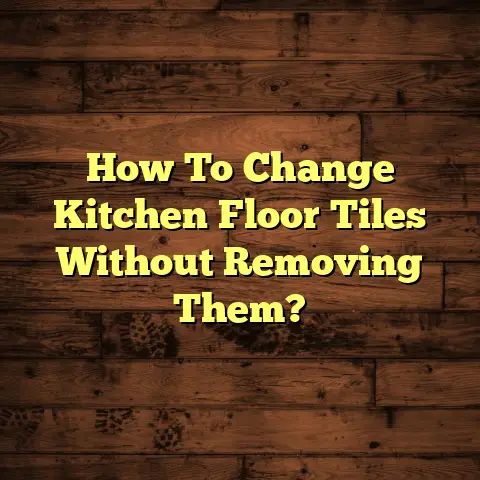Glue Tack Strips To Concrete? (1 Mistake to Avoid!)
Flooring, man, it’s the unsung hero
of home improvement.
Think about it:
it sets the stage for everything else.
A fresh floor can breathe new life into
a tired room, turning a drab space
into something spectacular.
And let’s
be honest, ripping up that old,
worn-out carpet and laying down something
new is just plain satisfying.
One of the coolest things about flooring
is how easily you can switch things up.
Want a cozy vibe in your living room?
Bam!
Plush carpet.
Need something durable
and easy to clean in the kitchen?
Hello,
vinyl plank!
And when it comes to
carpet, especially on concrete, glue
tack strips can be a game-changer.
Now, I know what you’re thinking:
“Glue… to concrete?
Sounds messy!”
But trust me, when done right, it’s a
clean and effective way to secure your
carpet.
Traditional tack strips, you
know, the ones with the little nails,
aren’t always the best option for
concrete.
They can be a pain to install,
and honestly, they don’t always hold
that well.
That’s where glue tack strips come in.
They offer a simpler solution, especially
in situations where you can’t, or don’t
want to, drill into the concrete.
They’re flexible, easy to work with,
and provide a solid grip.
But here’s the kicker: there’s a
sneaky little mistake that a lot of
people make when gluing tack strips to
concrete.
It’s a mistake that can lead
to poor adhesion, a wobbly carpet, and
a whole lot of frustration.
And trust
me, I’ve seen it happen way too many
times in my years as a flooring contractor.
So, what is this critical error?
It’s
all about the prep work, my friend.
Specifically, neglecting to properly
prepare the concrete surface before
gluing down those tack strips.
I’m
talking cleaning, leveling, and making
sure everything is just right for that
glue to bond.
In this article, I’m going to walk you
through everything you need to know
about glue tack strips, from what they
are to how to install them like a pro.
But more importantly, I’m going to
drill down (pun intended!) on why
surface preparation is absolutely
essential and how to avoid that one
critical mistake that can ruin your
entire flooring project.
Ready to
get started?
Let’s dive in!
Understanding Glue Tack Strips
So, what exactly are glue tack strips?
Well, imagine your standard tack strip,
the kind you’d nail into a wood subfloor.
Now, picture that same strip, but instead
of relying on nails, it has a flat back
designed to be glued down.
That’s a
glue tack strip in a nutshell.
Typically, these strips are made of
wood or plastic and feature those
familiar angled tacks that grip the
carpet backing.
The key difference is
the adhesive-friendly surface on the
underside.
Glue tack strips offer several advantages over traditional tack strips, especially when working with concrete:
Ease of Installation: No need for drills, hammers, or concrete nails.
Simply apply the adhesive and press the strip into place.
This saves time and effort, especially for DIYers.-
Flexibility: Glue tack strips can be easily cut and shaped to fit around curves and corners, giving you more design freedom.
No Concrete Damage: Drilling into concrete can sometimes cause cracks or other damage.
Glue tack strips eliminate this risk.-
Secure Hold: When installed correctly, glue tack strips provide a strong and reliable hold for your carpet.
Now, let’s talk about the glue.
Not
all adhesives are created equal.
You
can’t just grab any old tube of glue
from the hardware store and expect it
to work.
You need to choose an adhesive
specifically designed for bonding to
concrete and for use with tack strips.
Here are some common types of adhesives used with glue tack strips:
Construction Adhesive: This is a general-purpose adhesive that works well for many applications, including gluing tack strips to concrete.
Look for a high-strength formula that is specifically designed for bonding to porous surfaces like concrete.
Brands like Loctite PL Premium or Liquid Nails are popular choices.Epoxy Adhesive: For a super-strong and durable bond, epoxy is the way to go.
Epoxy adhesives are two-part systems that need to be mixed together before application.
They offer excellent resistance to moisture and temperature changes.Polyurethane Adhesive: These adhesives are known for their flexibility and ability to bond to a wide range of materials.
They are also resistant to water and chemicals.
When choosing an adhesive, consider the following factors:
Drying Time: How long will it take for the adhesive to fully cure?
Some adhesives dry faster than others, which can affect your installation timeline.Strength: How strong of a bond do you need?
For high-traffic areas, you may want to opt for a stronger adhesive like epoxy.-
Moisture Resistance: If your concrete floor is prone to moisture, choose an adhesive that is resistant to water damage.
VOC Content: VOCs (volatile organic compounds) are chemicals that can be released into the air as the adhesive dries.
If you are concerned about air quality, choose an adhesive with low or no VOCs.
Always read the manufacturer’s instructions
carefully before using any adhesive.
And don’t be afraid to ask a professional
for advice if you’re unsure which adhesive
is right for your project.
I can’t tell
you how many times I’ve seen people
make the wrong choice and end up with
a flooring disaster on their hands.
The Process of Gluing Tack Strips
to Concrete
Okay, now that we’ve covered the basics
of glue tack strips and adhesives, let’s
get into the nitty-gritty of the
installation process.
Here’s a step-by-step
guide to help you glue tack strips to
concrete like a seasoned pro:
Step 1: Gather Your Tools and Materials
Before you start, make sure you have
everything you need on hand.
This will
save you time and prevent frustration
later on.
Here’s a list of essential
tools and materials:
- Glue tack strips
- Appropriate adhesive for concrete
- Caulk gun (for applying adhesive)
- Utility knife or scissors
- Measuring tape
- Chalk line or marker
- Vacuum cleaner
- Scraper or putty knife
- Concrete cleaner or degreaser
- Moisture meter (optional but recommended)
- Concrete primer (optional but recommended)
- Safety glasses
- Gloves
Step 2: Prepare the Concrete Surface
This is the most crucial step, so pay
close attention!
As I mentioned earlier,
neglecting to properly prepare the concrete
surface is the biggest mistake people
make when gluing tack strips.
Here’s
how to do it right:
Clean the Concrete: Start by thoroughly cleaning the concrete surface.
Use a vacuum cleaner to remove any loose debris, dust, or dirt.
Then, use a scraper or putty knife to remove any stubborn residue, like old adhesive or paint.Degrease the Concrete: Concrete can often be contaminated with grease or oil, which can prevent the adhesive from bonding properly.
Use a concrete cleaner or degreaser to remove any grease or oil stains.
Follow the manufacturer’s instructions carefully.Check for Moisture: Moisture is the enemy of adhesion.
Before you start gluing, check the moisture level of the concrete using a moisture meter.
According to the Portland Cement Association, the moisture content of concrete should be below 4% for most adhesives to bond properly.
If the moisture level is too high, you’ll need to take steps to dry out the concrete before proceeding.
This might involve using a dehumidifier or allowing the concrete to air dry for several days.Level the Concrete (If Necessary): If your concrete surface is uneven, you’ll need to level it before gluing down the tack strips.
Use a self-leveling concrete compound to fill in any low spots or cracks.
Follow the manufacturer’s instructions carefully.Prime the Concrete (Optional but Recommended): Applying a concrete primer can significantly improve the adhesion of the glue tack strips.
Primer helps to seal the concrete surface, reduce porosity, and create a better bonding surface for the adhesive.
Choose a primer that is specifically designed for use with concrete and follow the manufacturer’s instructions carefully.
Step 3: Measure and Mark the Placement of the Tack Strips
Use a measuring tape and chalk line or
marker to mark the precise location where
you want to install the tack strips.
Typically, tack strips are placed around
the perimeter of the room, about 1/4 to
1/2 inch away from the wall.
Step 4: Cut the Tack Strips to Size
Use a utility knife or scissors to cut
the tack strips to the desired length.
Make sure the cuts are clean and straight.
Step 5: Apply the Adhesive
Load the adhesive into a caulk gun.
Apply
a continuous bead of adhesive to the
back of the tack strip.
Make sure the
bead is thick enough to provide a good
bond, but not so thick that it oozes out
from under the strip when you press it
into place.
Step 6: Position and Press the Tack Strips into Place
Carefully position the tack strip on the
concrete surface, aligning it with the
marks you made earlier.
Press firmly
along the entire length of the strip to
ensure good contact with the concrete.
Step 7: Repeat for All Tack Strips
Repeat steps 5 and 6 for all remaining tack strips.
Step 8: Allow the Adhesive to Cure
Allow the adhesive to cure completely
before installing the carpet.
Refer to
the manufacturer’s instructions for the
recommended curing time.
This can range
from a few hours to 24 hours or more.
Step 9: Install the Carpet
Once the adhesive has fully cured, you
can install the carpet.
Use a carpet
stretcher to stretch the carpet tightly
over the tack strips.
The tacks on the
strips will grip the carpet backing and
hold it in place.
Potential Challenges and How to Overcome Them
Uneven Concrete: As I mentioned earlier, uneven concrete can be a major challenge.
Use a self-leveling concrete compound to level the surface before gluing down the tack strips.Moisture Issues: If you have moisture problems, you’ll need to address them before installing the carpet.
Consider using a moisture barrier underlayment to protect the carpet from moisture damage.Difficult Corners: Cutting and fitting tack strips around corners can be tricky.
Use a utility knife to make small, precise cuts.
You may also need to use a small piece of tack strip to fill in any gaps.Adhesive Squeeze-Out: If you apply too much adhesive, it may squeeze out from under the tack strips when you press them into place.
Wipe away any excess adhesive with a damp cloth.
By following these steps and taking the time to properly prepare the concrete surface, you can successfully glue tack strips to concrete and achieve a beautiful and long-lasting carpet installation.
The One Mistake to Avoid
Okay, let’s get down to brass tacks
(again, pun intended!).
We’ve talked
about what glue tack strips are, how to
install them, and the importance of
choosing the right adhesive.
But now,
it’s time to focus on the one critical
mistake that can derail your entire
project: neglecting to properly prepare
the concrete surface.
I can’t stress this enough.
Surface
preparation is not an optional step.
It’s not something you can skip to save
time or effort.
It’s the foundation upon
which your entire flooring project rests.
So, what happens when you don’t properly
prepare the concrete?
Let me paint you
a picture:
Poor Adhesion: The adhesive simply won’t bond properly to a dirty, greasy, or dusty surface.
This means the tack strips will be loose and wobbly, and they won’t be able to hold the carpet securely.Curling Carpet: If the tack strips aren’t properly adhered to the concrete, the carpet can start to curl up at the edges.
This not only looks bad, but it can also be a tripping hazard.Increased Wear and Tear: A poorly installed carpet is more susceptible to wear and tear.
It can stretch, wrinkle, and even come loose from the tack strips over time.Mold and Mildew Growth: If the concrete surface is damp or has a high moisture content, mold and mildew can grow under the carpet.
This can lead to unpleasant odors, health problems, and costly remediation.
But why is surface preparation so vital? Let’s break it down:
Moisture: Concrete is porous, which means it can absorb moisture from the ground.
This moisture can interfere with the adhesive’s ability to bond properly.
According to the Concrete Manoifacturer Association, concrete can take up to a year to fully cure and dry depending on the climate and thickness.Dust and Debris: Dust, dirt, and other debris can create a barrier between the adhesive and the concrete surface.
This prevents the adhesive from making direct contact with the concrete, resulting in a weak bond.Grease and Oil: Grease and oil can also prevent the adhesive from bonding properly.
These substances can create a slippery layer on the concrete surface, making it difficult for the adhesive to grip.-
Existing Coatings: If the concrete surface has been previously coated with paint, sealant, or other coatings, these coatings can interfere with the adhesive’s ability to bond properly.
So, what specific steps should you take
to adequately prepare the concrete before
applying glue tack strips?
Here’s a
recap:
Clean the Concrete: Vacuum up any loose debris, dust, or dirt.
Then, use a scraper or putty knife to remove any stubborn residue.-
Degrease the Concrete: Use a concrete cleaner or degreaser to remove any grease or oil stains.
Check for Moisture: Use a moisture meter to check the moisture level of the concrete.
If the moisture level is too high, take steps to dry out the concrete before proceeding.-
Level the Concrete (If Necessary): Use a self-leveling concrete compound to fill in any low spots or cracks.
-
Prime the Concrete (Optional but Recommended): Apply a concrete primer to seal the concrete surface, reduce porosity, and create a better bonding surface for the adhesive.
I’ve seen firsthand the consequences of
skipping these steps.
I remember one
job where the homeowner decided to save
time by simply sweeping the concrete floor
before gluing down the tack strips.
A
few weeks later, the carpet started to
curl up at the edges, and the homeowner
had to pay me to come back and redo the
entire installation.
Talk about a costly
mistake!
Another time, I worked on a project where
the concrete floor had a high moisture
content.
The homeowner didn’t bother to
check the moisture level before installing
the carpet.
Within a few months, mold
started to grow under the carpet, and the
homeowner had to pay thousands of dollars
to have the mold removed.
These are just a few examples of what can
happen when you neglect to properly
prepare the concrete surface before gluing
down tack strips.
Trust me, it’s not
worth the risk.
Take the time to do it
right the first time, and you’ll save
yourself a lot of headaches (and money)
in the long run.
Conclusion
Alright, we’ve covered a lot of ground
here.
We’ve explored the world of glue
tack strips, discussed the different
types of adhesives you can use, and
walked through the step-by-step
installation process.
But most importantly, we’ve zeroed in on that one critical mistake that can make or break your entire flooring project: neglecting to properly prepare the concrete surface.
I hope I’ve made it clear just how
important this step is.
It’s not an
optional extra, it’s the foundation
upon which your entire installation
rests.
Without proper surface
preparation, you’re setting yourself
up for poor adhesion, curling carpet,
increased wear and tear, and even mold
growth.
But don’t let this scare you off!
Gluing
tack strips to concrete is a totally
achievable project, even for DIYers.
Just remember to take your time, follow
the steps I’ve outlined, and most
importantly, don’t skimp on the surface
preparation.
Flooring projects have the power to
transform a space.
They can add warmth,
comfort, and style to your home.
And
with the right knowledge and approach,
you can successfully install glue tack
strips on concrete and create a beautiful
and functional space that you’ll enjoy
for years to come.
So, go forth and conquer that flooring
project!
Just remember to clean, degrease,
check for moisture, level (if necessary),
and prime.
And if you ever have any
doubts, don’t hesitate to consult with
a professional.
We’re here to help!





